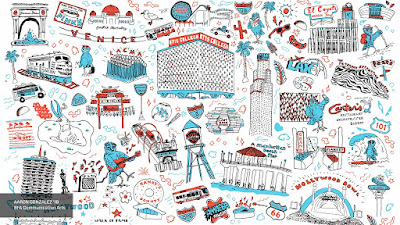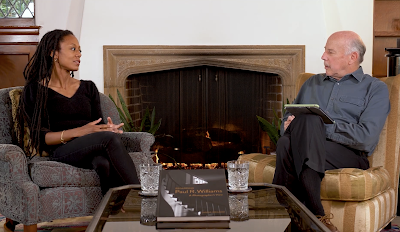Read on for the latest on projects I'm involved with: Modernism Week; Wasted and a visit to Homeboy Electronics Recyling, a 3D Printed Building and the Harnessing Plants Initiative; FORT: LA Trail drops; a talk with Lorcan O'Herlihy at Helms Bakery District; the launch of Season 2 of Rodeo Drive: The Podcast; and a talk about the 2021 Otis Report on the Creative Economy.
The 2021 OTIS REPORT ON THE CREATIVE ECONOMY
Thursday, February 25, 10 am
In 2007, Otis College of Art and Design released its first Report on the Creative Economy. The past president Samuel Hoi reasoned that the numbers of people involved in the arts and design, entertainment and architecture were so big and so integral to the life and economy of the Southland and the state of California that they warranted tracking and assessment.
As it turns out the report has become somewhat of a mirror of changing times, monitoring what sectors of the industry are up and down and, more recently, tackling the socio-economic dimensions of the creative industries: the gig economy and access to housing, for example, and, last year, race and diversity in the design professions.
On Thursday, February 25, at 10am, the school will release the 2021 Otis Report on the Creative Economy. Obviously, it
will reflect the huge challenges of 2020; the pandemic caused the loss of many jobs in the arts, even as heated up some sectors; and challenged designers and artists to adapt creatively to new ways of working and living.
The event will feature presentations from Charles Hirschhorn, president; Representative Karen Bass (37th District); Adam Fowler, Director of Research, Beacon Economics; and Julie Baker, Executive Director, Californians for the Arts/California Arts Advocates.
At 11am I will moderate a discussion entitled The Recovery of the
Creative Economy: From the Nation to the Neighborhood.
Speakers are: Ben Allen, California
State Senator, 26th District; Julie Baker, Executive Director,
Californians for the Arts/California Arts Advocates; Gustavo Herrera,
Executive Director, Arts for LA; Jason Foster, President and COO,
Destination Crenshaw.
Follow-up: This event is now passed. The panel discussed proved quite lively. You can witness the entire event, here.
LORCAN O'HERLIHY PUTS THE SOCIAL IN ARCHITECTURE AT HELMS
Thursday, February 18, 6:30 pm
Lorcan O’Herlihy spent his childhood wandering the great cities of the world. His father Dan O’Herlihy was an actor and took his family on overseas shoots. From time spent hanging out in urban centers like Rome and London, Lorcan developed a deep appreciation for social space.
He and his team at Lorcan O'Herlihy Architects (LOHA) have since made a mark with housing, workplaces and cultural buildings that put human connectivity at their center, while emphasizing bold design (as in Formosa 1140 and its accompanying pocket park, above).
This past Thursday, February 18, Lorcan and I talkd about LOHA’s latest monograph Architecture Is a Social Act, published by Frame. They will discuss his peripatetic childhood and how it shaped his worldview, and how he navigates tight budgets and stakeholder needs to integrate common space.
Lorcan
will also update us on a fascinating new project of his at 410 Rossmore
Avenue. He and development company Domus will add five new floors of
co-living space to a 90-year-old apartment building in Hancock Park.
When: Thursday, February 18th from 6:30 to 7:30 pm. Register here. To purchase a signed copy of the book, please visit Arcana: Books on the Arts.
This even is now passed. But you can view it here. The passcode is: EqR5ff@q
MODERNISM WEEK ONLINE
Through February 28, 2021
In a normal year, thousands of people would be descending on Palm Springs this month for the annual midcentury design lovefest known as Modernism Week. Needless to say, it has been upended by the pandemic.
In-person events will take place in April, assuming restrictions have been lifted. But if you need a fix right now
you can take couch surf the "greatest desert resort town in the entire
world" on tours with the irrepressible tour guide of retro, Charles Phoenix; and with Bert, who in a usual year, would be driving one of the Palm Springs tour buses. through February.
These are just two of an impressive collection of 20 videos created by the Modernism Week staff and board (which I recently joined).
The Modernism Week Online Experience takes on topics as wide ranging as the connection between nudism and Modernism; the future planning of Palm Springs; and the work and life of Paul R Williams, discussed by photographer Janna Ireland and Alan Hess (seen, sitting in a socially distanced fireside chat, below).
They also look beyond the Coachella Valley, to Modern New Canaan and the Midwest, and back into the history of Hollywood musicals and their fabulous costumes. You can hear the epic story behind the creation of the Farnsworth House, in a conversation between Mark Davis and Broken Glass author Alex Beam.
For those who want to accessorize their lives with a tangible piece of Modern style, there's an online auction. Sales will go to fund student scholarships and other MW programs.
Modernism Week Online Experience is on sale now. Programs will stream until February 28, 2021.
Best of Modernism Auction is taking bids through February 15, 2021.
Modernism Week takes place April 8 to 18.
WASTED: HOMEBOY ELECTRONICS RECYCLING/3D PRINTED BUILDINGS
Wasted: Neat Solutions to the Dirty Problem of Waste continues through February on KCRW's Greater LA, with episodes on e-waste, or electronic waste; 3D printed buildings and construction and demolition waste; iFixit and the Right to Repair; and the Harnessing Plants Initiative.
E-waste is the fastest growing waste stream in the world and contributor to toxic mountains of plastics, metals and minerals.
In this episode we meet the folks at Homeboy Electronics Recycling, a for-profit branch of Homeboy Industries. There, formerly incarcerated or gang-involved young people get to "de-manufacture," refurbish and reuse laptops, desktops, audio-video equipment, printers, fax machines and more.
The concept is to give people a second chance while giving "electronics and these precious metals a second chance, instead of discarding these items, and these people from our society and thinking, we never have to think about it again."
That's according to HER's Lulu Kornspan, who shares the story of this social enterprise, along with her colleagues Brian Fox, Xuong "X" Cam and "D-Man" expert Jerry Garcia, above. In his spare time Fox also co-runs an art collective Media Pollution, making art out of e-waste. Check out their artworks, like this one, below.
On this episode, we visited a backyard structure that had been 3D printed by a company named Mighty Buildings. The company believes that by "printing" only the material they use, they can reduce about efforts to reduce construction and demolition waste, which currently makes up around 30 percent of the landfill.
Richard Ludt, an interior demolition specialist, points out that it is typically not the structure but rather the particleboard and laminated wood fixtures and fittings that are the hazardous elements in a building. So a Mighty Buildings only helps fix the waste problem if the materials are non-toxic, and recyclable at the end of their life.
Find out what a 3D printed shell is made of, and how Mighty Buildings are tackling toxic materials along with waste, in this episode.
IFixit and the Right to Repair airs February 16; Harnessing Plants Initiative airs February 23.
FORT LA TRAIL OF MULTIFAMILY HOUSING
Launches February 17
Russell Brown is Southland native who has long admired the region’s distinctive residential architecture. But he found it a challenge to locate and visit those buildings, requiring "navigating a motley collection of websites for scraps of information about the architects, history, or locations of the most important structures."
So he established Friends Of Residential Treasures: LA (FORT: LA), a nonprofit group of architecture historians and enthusiasts, and has created a website displaying architectural trails. His goal is to inspire fellow Angelenos and tourists to "venture beyond their own 'urban village' to experience other parts of the city."
FORT: LA asked me to contribute a trail so I chose five very fine multifamily housing complexes in Los Angeles. This trail launches on February 17. It offers a preview of ideas I'll be exploring a forthcoming book, Common Ground: Multifamily Housing in Los Angeles, to be published by Angel City Press.
I believe the owner-occupied, single family home has been mythologized and idealized in a region where the plurality of people rent and/or live in multi-unit buildings. Developers and designers have served the need for connected housing for over century. Out of often expedient construction has come a legacy of innovative multifamily housing that delivers some of the charms of the single family home -- the inside-outside living experience -- along with a sense of human connection that enhances life in a sprawling and, for some, isolating region.
These buildings date back to the bungalow courts of over 100 years ago and can be found today in multistory complexes with gardens on the roof and shared amenities.
The five I chose for this trail are:
--Horatio West Court, Santa Monica, designed by Irving Gill--Strathmore Apartments, Westwood Village, designed by Richard Neutra--Village Green, Baldwin Hills, designed by Clarence Stein and Reginald Davis Johnson--Formosa 1140, West Hollywood, designed by Lorcan O'Herlihy (see talk below)--Gardenhouse, Beverly Hills, designed by MAD Architects (in picture, above).
RODEO DRIVE: THE PODCAST -- SEASON 2
From Runway to Screen: Reimagining the Fashion Show
Retail was already in flux and then came the pandemic and social upheaval. So where does that leave Rodeo Drive? That's been a through line to Rodeo Drive: The Podcast, a series hosted by fashion doyen Bronwyn Cosgrave, written by yours truly, that looks at how three blocks in Beverly went from bridle path to iconic destination for luxury goods.
The founding of Giorgio Beverly Hills; the arrival of the inimitable Bijan; Michael Chow's game-changing design for Giorgio Armani; Jay Leno and the Concours d'Elegance; LA-inspired lines for Moncler and the rethinking of the red carpet... these were some of the stories in Season 1, featuring insiders Rose Apodaca, Nicolas Bijan, Joan Juliet Buck, Ruth E. Carter, Michael Chow, Simon Doonan, Pari Eshan, Robert Hayman, Stephen Jones OBE, Jay Leno, Faye McLeod, Dame Zandra Rhodes, Cameron Silver and Sergio Zambon.
Now comes Season 2, and it kicked off this month with a fascinating look at the rise and fall and reinvention of the fashion show, along with the emergence of the fashion film. These elaborate videos like the one created by director Matteo Garrone to showcase Dior's Haute Couture Spring-Summer 2021 Collection, designed by Maria Grazia Chiuri.
"I think a good Fashion Film is something between a sentence of a poem and a poem," says Solve Sundsbo, a photographer who specializes in moving imagery of fashion. Catch this and past episodes here.













